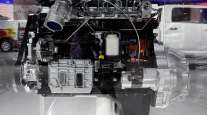Senior Reporter
Jacobs Prepares for Tougher Emissions Standards

[Stay on top of transportation news: Get TTNews in your inbox.]
Jacobs Vehicle Systems is taking to the road to demonstrate its latest technologies directly to fleets and others as the company retools how it wants to be viewed — as a provider of emissions technology, not just the place for engine brakes.
“Everyone is finally taking their look toward 2024 and 2027,” when emissions regulations toughen again, said Steve Ernest, vice president of engineering and business development. “They are surveying the market again for what technologies are available. Some companies have already made their strategic decision on what’s happening and what they are going to take forward in 2024, but there are still several others that are still in the decision process.”

Pare
As truck makers evaluate their choices, fleets can play a bigger role, according to the company.
“We had to change our approach from a push strategy to a pull strategy,” added Paul Paré, senior director of business development. “And we want to pull that message back to the manufacturers, meaning fleets demand the Jacobs technology on the trucks they order and are pulling that back to the truck makers.”
The company is taking its new demonstrator truck equipped with technological enhancements to promote better fuel consumption, reduce harmful emissions and improve engine braking capabilities on tour in 2020. The enhancements include Jacobs’ patented High Power Density technology (HPD) and Active Decompression technology (ADT), showcased to truck maker executives, fleets, dealers and service providers throughout the U.S. and Canada.

HPD by Jacobs Vehicle Systems
HPD provides upgrades over traditional engine brakes, primarily centered on the modern-day need for increased retarding demands to compensate for lower engine operating speeds, smaller displacement engines, and decreased aerodynamic drag and decreased rolling resistance common with today’s trucks, according to Bloomfield, Conn.-based Jacobs.
Ernest said the noise level associated in the past with the engine brakes isn’t an issue on new trucks anymore because of the aftertreatment systems required on trucks built after 2007.
ADT operates to offset complications associated with anti-idling regulations by improving engine operation during startup and shutdown. This creates a more comfortable driver experience and helps reduce emissions and fuel consumption associated with idling.

ADT by Jacobs Vehicle Systems
At the same time, the company reported its Cylinder Deactivation technology (CDA) is under evaluation with the U.S. Department of Energy’s Super Truck II program, in which truck manufacturers and equipment suppliers develop and demonstrate cost-effective technologies to improve medium- and heavy-duty truck efficiency.
Jacobs’ CDA was installed on a 13-liter Navistar engine and revealed a 3% improvement in fuel consumption, and a corresponding decrease in nitrogen oxide emissions from the baseline of 0.107 grams per horsepower-hour to 0.097 grams in a heavy-duty federal test procedure transient cycle test. The NOx reduction is due to the increased exhaust temperatures during cold operation while in CDA mode, which pushes the selective catalytic reduction system to its most efficient range of 250 degrees to 400 degrees Celsius.
The system has undergone lab testing and optimization for several years and on a truck for nearly a year. CDA now is ready for additional tests on the road.
“Yes, we will always be the brake manufacturer,” Paré said, “but we have other technologies that are emissions beneficial.”
Want more news? Listen to today's daily briefing:




